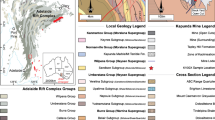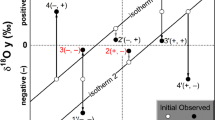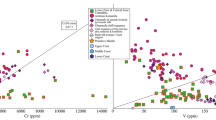Abstract
This paper presents principles of the method of modeling metal concentrations in sulfide at the occurrence of silicate–sulfide liquid immiscibility during middle and late stages of the crystallization of mafic–ultramafic magmas. The proposed approach combines the preliminary modeling of the crystallization of heterogeneous (melt + crystals) and initially sulfide-undersaturated systems with the calculation of the trace-element composition of sulfide liquid after its appearance in the system. The first part of the problem is solved using the sulfide version of the COMAGMAT-5 program, and the second part employs the modified Campbell–Naldrett equation. It was shown that a delay in silicate–sulfide liquid immiscibility and the low proportion of separated sulfide to major minerals are important factors of the geochemical evolution of sulfide liquid. By the example of the behavior of Cu, Pd, and Re, we discussed the reasons for differences between calculations for crystallizing multiphase cumulates and simplified (sulfide–silicate melt) systems.
Similar content being viewed by others
References
J.-P. Arguin, P. Page, S.-J. Barnes, S.-Y. Yu, and X.-Y. Song, “The effect of chromite crystallization on the distribution of osmium, iridium, ruthenium and rhodium in picritic magmas: an example from the Emeishan Large Igneous Province, Southwestern China.” J. Petrol. 57 (5), 1019–1048 (2016).
A. A. Ariskin and G. S. Barmina, “COMAGMAT: development of a magma crystallization model and its petrologic applications,” Geochem. Int. 42 (Suppl. 1), S1–S157 (2004).
A. A. Ariskin and L. V. Danyushevsky, “The sulfide COMAGMAT: Modeling R-factor and Cu–Ni–PGE tenors in sulfides for multiple-saturated magmas,” in 12th International Platinum Symposium, Yekaterinburg, Russia (Yekaterinburg, 2014), Proc. 1, pp. 15–16.
A. A. Ariskin, G. S. Barmina, M. Ya. Frenkel, and R. L. Nielsen, “COMAGMAT: a Fortran program to model magma differentiation processes,” Comp. Geosci. 19 (8), 1155–1170 (1993).
A. A. Ariskin, E. G. Konnikov, L. V. Danyushevsky, E. V. Kislov, G. S. Nikolaev, D. A. Orsoev, G. S. Barmina, and K. A. Bychkov, “The Dovyren Intrusive Complex: problems of petrology and Ni sulfide mineralization,” Geochem. Int. 47 (5), 425–453 (2009a).
A. A. Ariskin, L. V. Danyushevsky, E. G. Konnikov, G. S. Barmina, and G. S. Nikolaev, “Application of an olivine control line and COMAGMAT software for estimating composition of parental magma of the Yoko-Dovyren layered intrusion,” in Proceedings of 3rd International Conference Ultrabasite–Basite Complexes of Fold Areas and Related Deposits, Yekaterinburg, Russia, 2009b (Yekaterinburg, Russia, 2009b), Vol. 1, pp. 57–60 [in Russian].
A. A. Ariskin, G. S. Barmina, K. A. Bychkov, and L. V. Danyushevsky, “Parental magmas of mafic layered intrusions: using an updated COMAGMAT model for calculations of sulfide–silicate cotectics during their crystallization,” Northwestern Geol. 42 (Suppl.), 1–3 (2009).
A. A. Ariskin, K. A. Bychkov, L. V. Danyushevsky, A. W. McNeill, G. S. Barmina, and G. S. Nikolaev, “COMAGMAT-5: a new magma crystallization model designed to simulate mafic to ultramafic sulfide-saturated systems,” in Abstracts of 12th International Ni–Cu–(PGE) Symposium, Guiyang, China, 2012 (Guiyang, 2012), pp. 15–18.
A. A. Ariskin, L. V. Danyushevsky, K. A. Bychkov, A. W. McNeill, G. S. Barmina, and G. S. Nikolaev, “Modeling solubility of Fe–Ni sulfides in basaltic magmas: the effect of Ni in the melt,” Econ. Geol. 108 (8), 1983–2003 (2013).
A. A. Ariskin, L. V. Danyushevsky, E. G. Konnikov, R. Maas, Yu. A. Kostitsyn, A. McNeill, S. Meffre, G. S. Nikolaev, and E. V. Kislov, “The Dovyren intrusive complex (northern Baikal region, Russia): isotope–geochemical markers of contamination of parental magmas and extreme enrichment of the source,” Russ. Geol. Geophys. 56 (3), 411–434 (2015).
A. A. Ariskin, E. V. Kislov, L. V. Danyushevsky, G. S. Nikolaev, M. Fiorentini, S. Gilbert, K. Goemann, and A. Malyshev, “Cu–Ni–PGE fertility of the Yoko-Dovyren layered massif (Northern Transbaikalia, Russia): thermodynamic modeling of sulfide compositions in low mineralized dunites based on quantitative sulfide mineralogy,” Mineral. Deposita 51 (8), 993–1011 (2016).
S. J. Barnes, “Cotectic precipitation of olivine and sulfide liquid from komatiite magma and the origin of komatiite- hosted disseminated nickel sulfide mineralization at Mount Keith and Yakabindie, Western Australia,” Econ. Geol. 102 (2), 299–304 (2007).
S.-J. Barnes and Lightfoot, P.C. “Formation of magmatic nickel-sulfide ore deposits and processes affecting their copper and platinum-group element contents,” Ed. by J.W. Hedenquist, J.F.H. Thompson, R.J. Goldfarb, and J.P. Richards, Econ. Geol. 100th Anniv. Vol., 179–213 (2005).
S.-J. Barnes and E. M. Ripley, “Highly siderophile and strongly chalcophile elements in magmatic ore deposits,” Rev. Mineral. Geochem. 81, 725–774 (2016).
S. V. Bolikhovskaya, A. A. Yaroshevskii, and E. V. Koptev- Dvornikov, “Simulation of the geochemical structure of the Ioko-Dovyren Layered Intrusion, northwestern Baikal area,” Geochem. Int. 45 (6), 519–538 (2007).
A. Borisov and H. Palme, “Experimental determination of the solubility of platinum in silicate melts,” Geochim. Cosmochim. Acta 61 (20), 4349–4357 (1997).
I. H. Campbell and A. J. Naldrett, “The influence of silicate: sulfide ratios on the geochemistry of magmatic sulfides,” Econ. Geol. 74 (6), 1503–1506 (1979).
D. A. Holwell and R. R. Keays, “The formation of low-volume, high-tenor magmatic PGE–Au sulfide mineralization in closed systems: evidence from precious and base metal geochemistry of the Platinova Reef, Skaergaard Intrusion, East Greenland,” Econ. Geol. 109 (2), 387–406 (2014).
V. S. Kamenetsky, J.-W. Park, J. E. Mungall, E. V. Pushkarev, A. I. Ivanov, M. B. Kamenetsky, and G. M. Yaxley, “Crystallization of platinum-group minerals from silicate melts: evidence from Cr-spinel-hosted inclusions in volcanic rocks,” Geology 43 (10), 903–906 (2015).
E. V. Kislov, Yoko-Dovyren Layered Massif (Buryatsk. Nauchn. Ts., Ulan-Ude, 1998) [in Russian].
C. M. Lesher and O. M. Burnham, “Multicomponent elemental and isotopic mixing in Ni–Cu–(PGE) ores at Kambalda, Western Australia,” Can. Mineral. 39 (2), 421–446 (2001).
C. Li and E. M. Ripley, “Sulfur contents at sulfide-liquid or anhydrite saturation in silicate melts: empirical equations and example applications,” Econ. Geol. 104 (3), 405–412 (2009).
J. E. Mungall and J. M. Brenan, “Partitioning of platinumgroup elements and Au between sulfide liquid and basalt and the origins of mantle–crust fractionation of the chalcophile elements,” Geochim. Cosmochim. Acta 125, 265–289 (2014).
A. J. Naldrett, Magmatic Sulfide Deposits: Geology, Geochemistry and Exploration (Springer, Heidelberg–Berlin, 2004).
G. S. Nikolaev, A. A. Ariskin, G. S. Barmina, M. A. Nazarov and R. R. Almeev, “Test of the Ballhaus–Berry–Green Ol–Opx–Sp oxybarometer and calibration of a new equation for estimating the redox state of melts saturated with olivine and spinel,” Geochem. Int. 54 (4), 301–320 (2016).
P. Page and S.-J. Barnes, “The influence of chromite on osmium, iridium, ruthenium and rhodium distribution during early magmatic processes,” Chem. Geol. 420, 51–68 (2016).
J.-W. Park, I. H. Campbell, and R. J. Arculus, “Platinumalloy and sulfur saturation in an arc-related basalt to rhyolite suite: Evidence from the Pual Ridge lavas, the Eastern Manus Basin,” Geochim. Cosmochim. Acta 101, 76–95 (2013).
C. Patten, S.-J. Barnes, E. A. Mathez, and F. E. Jenner, “Partition coefficients of chalcophile elements between sulfide and silicate melts and the early crystallization history of sulfide liquid: LA–ICP–MS analysis of MORB sulfide droplets,” Chem. Geol. 358, 170–188 (2013).
N. D. Tolstykh, D. A. Orsoev, A. P. Krivenko, and A. E. Izokh, Noble Metal Mineralization in the Layered Ultrabasite–Basite Massifs of the Southern Siberian Platform (Parallel’, Novosibirsk, 2008) [in Russian].
Author information
Authors and Affiliations
Corresponding author
Additional information
Original Russian Text © A.A. Ariskin, K.A. Bychkov, G.S. Nikolaev, 2017, published in Geokhimiya, 2017, No. 5, pp. 453–462.
Rights and permissions
About this article
Cite this article
Ariskin, A.A., Bychkov, K.A. & Nikolaev, G.S. Modeling of trace-element composition of sulfide liquid in a crystallizing basalt magma: Development of the R-factor concept. Geochem. Int. 55, 465–473 (2017). https://doi.org/10.1134/S0016702917050032
Received:
Accepted:
Published:
Issue Date:
DOI: https://doi.org/10.1134/S0016702917050032




